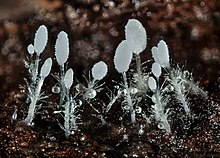Hirticlavula
| Hirticlavula | |
|---|---|

| |

| |
| Scientific classification | |
| Domain: | Eukaryota |
| Kingdom: | Fungi |
| Division: | Basidiomycota |
| Class: | Agaricomycetes |
| Order: | Agaricales |
| Family: | Clavariaceae |
| Genus: | Hirticlavula J.H.Petersen & Læssøe (2014) |
| Species: | H. elegans
|
| Binomial name | |
| Hirticlavula elegans J.H.Petersen & Læssøe (2014)
| |
| Hirticlavula saprotrophic | |
|---|---|
| Edibility is unknown | |
Hirticlavula is a fungal
Taxonomy
Hirticlavula elegans was described based on collections dating back to 1995. It was provisionally reported in 2009 in the
Description

Hirticlavula elegans produces white
The
The hairs on the stem are straight and point away from the substrate, emerging from the stems at oblique angles. They are 150 to 250 μm in length; at the base, they are 1.5 to 2.5 μm in width, while at the rounded to club-shaped tips, they are 3 to 4.5 μm in width. The hairs do not branch, have moderately thick
It is unknown whether the fruit bodies are edible, but they are unlikely to be of interest to mushroom hunters due to the small size.[2][3]
Similar species
Hirticlavula elegans fruit bodies are highly distinctive. The characteristic hairy stems are very different from those of any other species in the Clavariaceae. Hairy stems are seen among more distant relatives, including members of
Distribution and ecology
Hirticlavula elegans is known from Denmark and Norway. The fruit bodies grow directly from the wood or, more usually, the bark of
See also
References
- ^ Petersen, Davey, and Læssøe, p. 1.
- ^ a b c Brix, Lise (16 February 2015). "Ny svampeart opdaget i Nordjylland" [New fungal species discovered in Jutland] (in Danish). Videnskab.dk. Retrieved 19 February 2015.
- ^ a b "Denmark: Scientists find new 'pretty' fungus species". BBC News. 18 February 2015. Retrieved 19 February 2015.
- ^ Petersen, Davey, and Læssøe, p. 2.
- ^ a b c d Petersen, Davey, and Læssøe, p. 4.
- ^ Petersen, Davey, and Læssøe, p. 4, 7.
- ^ Petersen, Davey, and Læssøe, p. 7.
Cited texts
- Petersen, Jens H.; Davey, Marie L.; Læssøe, Thomas (2014). "Hirticlavula elegans, a new clavarioid fungus from Scandinavia". .
